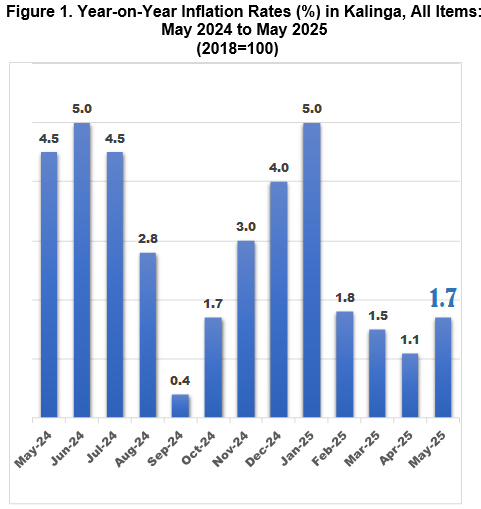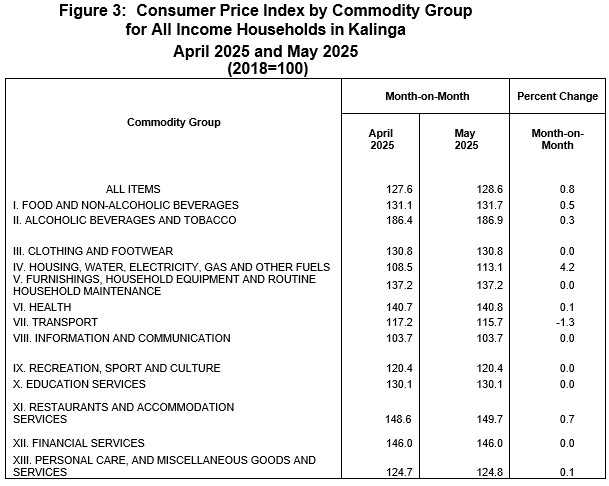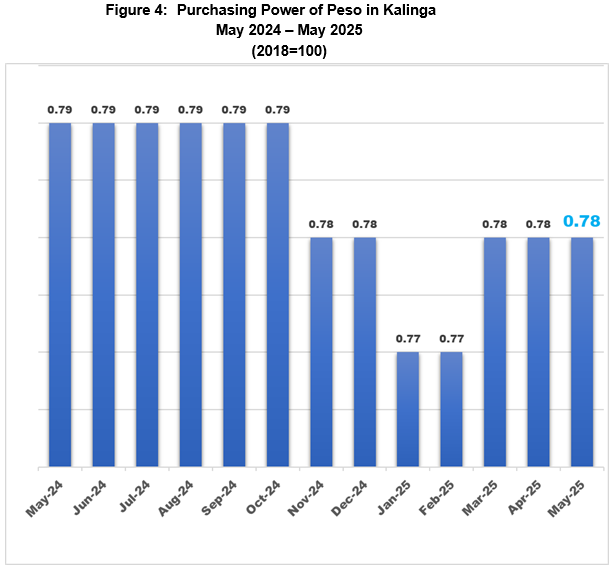Headline Inflation
Kalinga’s headline inflation or overall inflation goes up to 1.7 percent in May 2025 from 1.1 percent in April 2025. Inflation in May 2024 was at 4.5 percent.

In the year-on-year comparison, the Consumer Price Index (CPI) in All Items posted at 1.7 percent from 126.5 to 128.6.
Moreover, the increase in the province inflation was brought about by the increase in the Consumer Price Index of the following items:
a. Food and Non-alcoholic Beverages with 2.9 percentage point (May 2024 128.0 to May 2025 131.7);
b. Housing, Water, Electricity, Gas and Fuels at 2.4 percentage point (May 2024 110.4 to May 2025 113.1);
c. Education with 1.9 percentage point (May 2024 127.7 to May 2025 130.1);
d. Furnishing, Household Equipment and Routine Household Maintenance with 1.6 percentage point (May 2024 135.0 to May 2025 137.2);
e. Personal Care Goods and Miscellaneous Services with 1.5 percentage point (May 2024 123.0 to May 2025 124.8);
f. Restaurant, Miscellaneous Goods and Services with 1.4 percentage point (May 2024 147.7 to May 2025 149.7);
g. Clothing and Footwear with 1.1 percentage point (May 2024 129.4 to May 2025 130.8);
h. Recreation and Culture with 1.0 percentage point (May 2024 119.2 to May 2025 120.4);
i. Alcoholic Beverages and Tobacco at 0.9 percentage point (May 2024 185.3 to May 2025 186.9);
j. Health with 0.6 percentage point (May 2024 139.9 to May 2025 140.8); and
k. . Information and Communication with 0.4 percentage point (May 2024 103.3 to May 2025 103.7).
On the other hand, there is a decrease in the commodity group of Transportation with -4.3 percentage point (May 2024 120.9 to May 2025 115.7) and still there is no change in the commodity group of Financial Services.

PRICE SITUATION: Month-on-Month
The increasing changes in the monthly CPI of the month were the result of the increasing prices from the group of the following items:
a. Housing, Water, Electricity, Gas and Fuels with 4.2 percent change from 108.5 to 113.1;
b. Restaurant and Accommodation services with 0.7 percent change from 148.6 to 149.7 and;
c. Food and Non-Alcoholic beverages with 0.5 percent change from 131.1 to 131.7;
d. Alcoholic Beverages and Tobacco with 0.3 percent change from 186.4 to 186.9;
e. Health with 0.1 percent change from 140.7 to 140.8 and;
f. Personal care and Miscellaneous goods and services and Recreation and Culture with 01. percent change from 124.7 to 124.8.
Meanwhile, there is a decrease of price with -1.3 percentage point from the group of Transportation (117.2 to 115.7).
Moreover, stable price with 0.0 percent change was posted on the group of the following groups:
a. Education Services with 130.1;
b. Clothing and Footwear with 130.8;
c. Furnishings, Household equipment and Routine Household maintenance with137.2;
d. Information and communication with 103.7;
e. Recreation, Sport and culture with 120.4; and
f. Financial Services with 146.0

Purchasing Power of Peso
The Purchasing Power of Peso (PPP) in Kalinga was valued at 0.78 this
May 2025, 1 centavo lower than the PPP of May 2024 with 0.79 centavos.

Technical Notes:
Price – is the amount or value paid in exchange for the commodity, or a service rendered.
Retail/Consumer Price – refers to the price at which a commodity is sold in small quantities for consumption.
Weight – a value attached to a commodity or group of commodities to indicate the relative importance of that commodity or group of commodities in the market basket.
Market Basket – a term used to refer to a sample of goods and services that are commonly purchased and bought by an average Filipino household.
Consumer Price Index (CPI) – is a measure of the average change overtime in the prices paid by urban consumers for a market basket of consumer goods and services.
Inflation Rate - is the percentage increase or decrease in prices during a specified period, usually a month or a year and it is derived from CPI. It is interpreted in terms of declining purchasing power of money.
Unit of Measure - refers to which a commodity is customarily traded in the market, and it is the actual unit in which the associated values are measured.
Commodity Specifications – refers to the detailed description of the commodity such as a brand packaging, size and unit of measure or other characteristics that will best describe the product/commodity and are important in the determination of prices.
Uses of the CPI
As an indicator, the CPI is the most widely used in the calculation of the inflation rate and purchasing power of the peso. It is a major statistical series used for economic analysis and as monitoring indicator of government economic Policy.
The CPI is also used as a deflector to express value series in real terms, which is, measuring the change in actual volume of transaction by removing the effects of price changes. The CPI also serves as input in wage adjustments through the collective bargaining agreements.
sgd.
MARIBEL M. DALAYDAY
Chief Statistical Specialist

